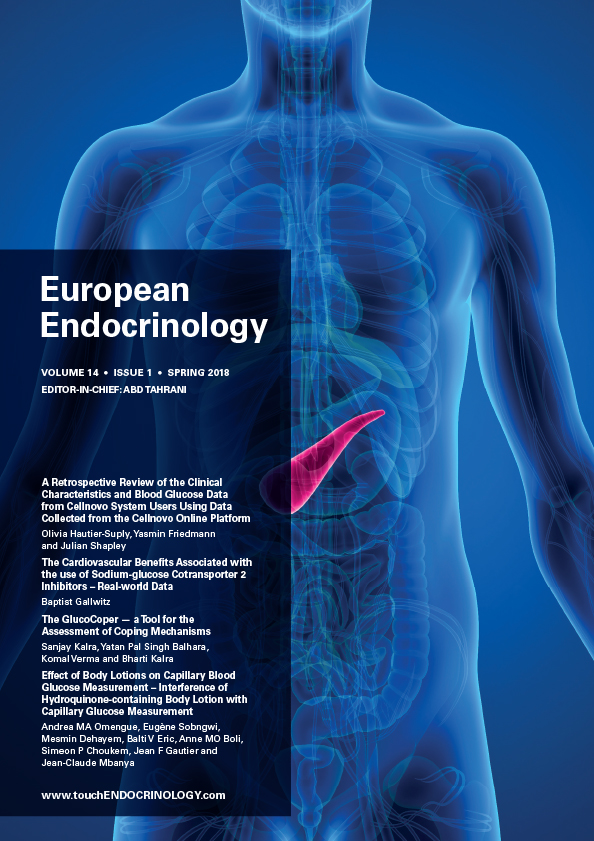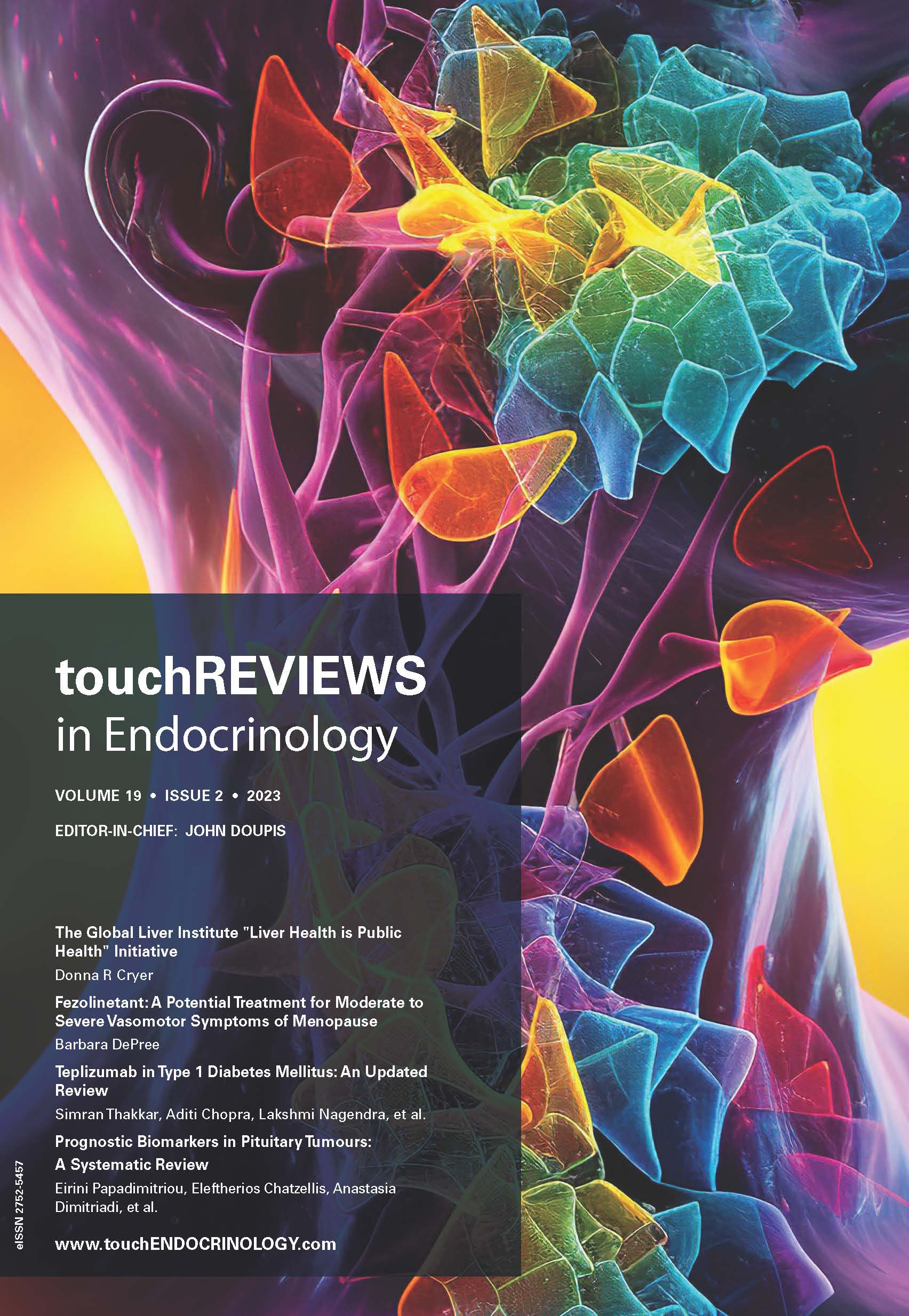EUROPEAN ENDOCRINOLOGY VOLUME 14 – ISSUE 1 – SPRING 2018
Welcome to the Spring 2018 edition of European Endocrinology opened by our Editor-in-Chief Abd Tahrani, with the exciting news the the journal is now indexed on PubMed Central. Thank you to our Editorial Board for their continued support over the past few years.
This edition includes a selection of editorials, reviews, research and case reports on a variety of topics currently being discussed in the areas of diabetes and thyroid disorders. Editorial Board member Sanjay Kalra and colleagues provide insights into mindfulness meditation in diabetes and Adolfsson and colleagues discuss how to select an appropriate blood glucose monitoring system, whilst Baptist Gallwitz reviews the real-world data on the cardiovascular benefits associated with sodium-glucose cotransporter 2 inhibitors.
We hope you enjoy this edition, and we welcome you to submit your reviews and research to our upcoming editions here.
Enjoy!
Foreword
I am delighted to open this edition with the exciting announcement that European Endocrinology is now officially indexed on PubMed Central. As a team we are very excited that our content will be included in this very well-respected database, and excited to share our articles with more doctors and researchers. We would like to take […]
Editorials
Many recent publications have increased our knowledge on several aspects of thyroid carcinoma, namely on the molecular mechanisms involved in the initiation and progression of neoplasias, on the clinical and histopathological evaluation of patients and tumour samples and on the definition of better prognostic markers. However, I would like to highlight the recent guidelines from […]
Fatigue is a frequently encountered symptom in clinical practice.1 This is especially so in endocrine clinics, which have a higher proportion of persons living with chronic disease. While debate continues regarding the exact definition and measurement of fatigue,2 it is not difficult to recognise fatigue in the medical setting. Defined as a feeling of tiredness […]
Reviews
People with type 2 diabetes mellitus (T2D) have a two- to four-fold increased risk for coronary heart disease compared to those without diabetes,1–3 as well as other vascular disorders (consisting of heart failure [HF], cardiac dysrhythmia, sudden death, hypertensive disease, pulmonary embolism, and aortic aneurysm). Heart failure is a particularly common complication of T2D and […]
During the past decade, we have seen a dramatic and growing shift from traditional self-monitoring of blood glucose (SMBG) to continuous glucose monitoring (CGM). Unlike SMBG, CGM devices offer the ability to collect glucose information in a way that allows diabetes patients and their healthcare professionals to dynamically assess glucose levels and trends through a […]
An effective basal-bolus regimen is the gold standard in type 1 diabetes mellitus (T1DM) management as it most closely resembles physiological beta-cell pancreatic insulin secretion. Multiple daily injections (MDI) are commonly used to deliver insulin; however, where these fail to manage glycated haemoglobin (HbA1c) within defined parameters, continuous subcutaneous insulin infusion (CSII, also known as […]
‘We are what we think. All that we are arises with our thoughts… Be the witness of your thoughts.’ – Gautama Buddha1 The biomedical approach in modern medicine focuses on disease as a deviation from the norm of measurable biological variables. The social, psychological and emotional dimensions of health are largely ignored. However, it is […]
Original Research
Diabetes mellitus is a major global health problem owing to its increasing prevalence, morbidity and mortality. Blood glucose control is paramount in patients with diabetes to optimise treatment and therefore delay the onset of acute and chronic complications and subsequent death. Capillary blood glucose measurement is the commonly used method to reflect daily glycaemic control […]
Diabetes mellitus is a worldwide epidemic disease, which requires continuous long-term medical care. In addition, a considerable degree of engagement is required by the patient in his or her disease management. India is now considered the diabetes capital of the world.1 The total number of people expected to suffer from diabetes will double globally from […]
Diabetes distress (DD) is a frequently documented aspect of living with diabetes.1 DD is defined as an emotional state characterised by extreme apprehension, discomfort or dejection due to perceived inability in coping with the challenges and demands of living with diabetes.2 The presence of DD impairs psychosocial functioning and prevents the achievement of optimal biomedical […]
Case Reports
18F-fluorocholine-positron emission tomography/computerized tomography (FC-PET/CT) has traditionally been used for disease localisation and management in oncology (e.g. hepatocellular carcinoma and prostate cancer).1 Diagnosis of parathyroid adenomas incidentally picked up in patients with malignancy who underwent FC-PET/CT led to its evaluation in parathyroid imaging.2 A few recent reports have suggested the beneficial role of PC-PET/CT in […]
Type 1 diabetes mellitus (T1DM) is the most common type of diabetes affecting children.1–3 Despite increasing awareness of early presentation of diabetes, a high number of children newly diagnosed with T1DM still present with diabetic ketoacidosis (DKA).4–7 DKA in children carries higher risk of mortality and morbidity compared to adults.8 Cerebral oedema is the most […]

Trending Topic
We are pleased to present the latest issue of touchREVIEWS in Endocrinology, which offers a timely and thoughtprovoking collection of articles that reflect both the continuity and evolution of diabetes and metabolic disease research. In an era where technology, public health priorities and clinical paradigms are shifting rapidly, this issue highlights the importance of evidence-based […]
Journal Archive
touchREVIEWS in Endocrinology (previously European Endocrinology) is a peer-reviewed, free-to-access, bi-annual journal comprising review articles, case reports, editorials, special reports and original research. It features balanced and comprehensive articles written by leading authorities, addressing the most important and salient developments in the field of endocrinology.
Latest articles videos and clinical updates - straight to your inbox
Log into your Touch Account
Earn and track your CME credits on the go, save articles for later, and follow the latest congress coverage.
Register now for FREE Access
Register for free to hear about the latest expert-led education, peer-reviewed articles, conference highlights, and innovative CME activities.
Sign up with an Email
Or use a Social Account.
This Functionality is for
Members Only
Explore the latest in medical education and stay current in your field. Create a free account to track your learning.

















